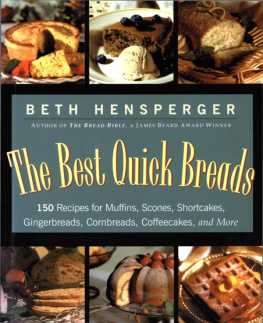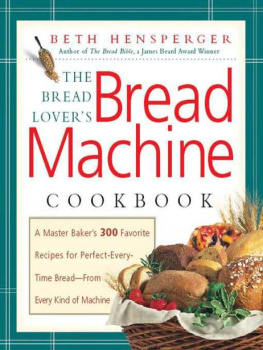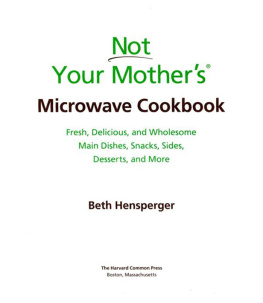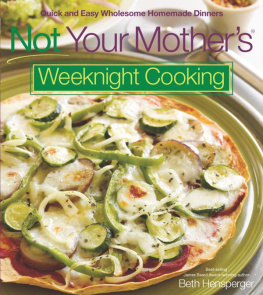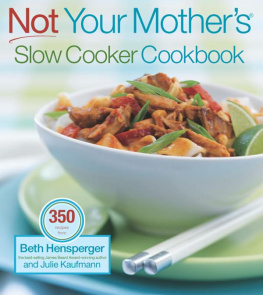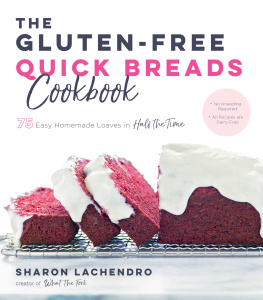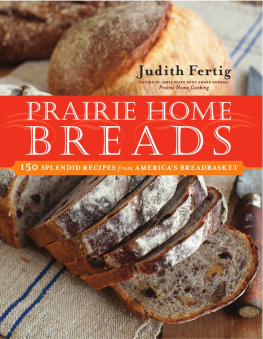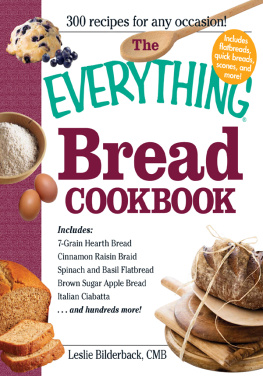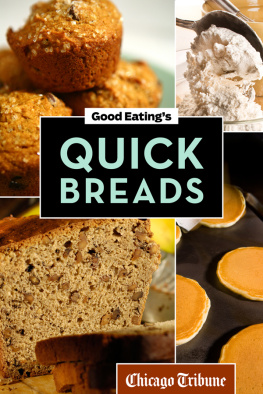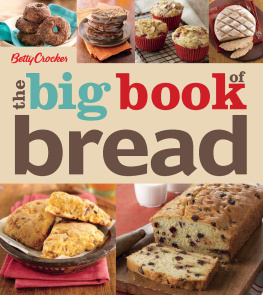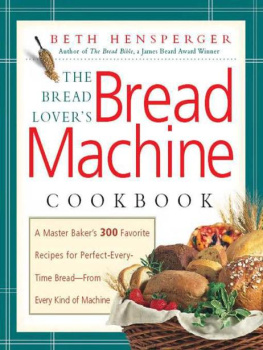The Harvard Common Press
535 Albany Street
Boston, Massachusetts 02118
Copyright 2000 by Beth Hensperger
Cover and book design by Night & Day Design
Illustrations copyright 2000 by Laura Tedeschi
All rights reserved. No part of this publication may be reproduced or transmitted in any form or by any means, electronic or mechanical, including photocopying, recording, or any information storage or retrieval system, without permission in writing from the publisher.
Some of the recipes in this book are revised and updated versions of recipes that appeared in Beth Henspergers The Art of Quick Breads (now out of print).
Printed in the United States of America
Printed on acid-free paper
Library of Congress Cataloging-in-Publication Data
Hensperger, Beth.
[Art of quick breads]
The best quick breads : 150 recipes for muffins, scones, shortcakes, gingerbreads, cornbreads, coffeecakes, and more / Beth Hensperger.
p. cm.
Originally published under title: The art of quick breads. San Francisco : Chronicle Books, 1994.
ISBN 1-55832-171-3 (pbk. : alk. paper)
1. Bread. I. Title.
TX769.H427 2000
641.815dc21
00-036962
Special bulk-order discounts are available on this and other Harvard Common Press books. Companies and organizations may purchase books for premiums or resale, or may arrange a custom edition, by contacting the Marketing Director at the address above.
10 9 8 7 6 5 4 3
For my mother
Inspiration in the Kitchen
Good quick breads are made from good recipes. This book contributes traditional-style recipes that bake to perfection and have an exceptionally pleasing taste. Breads of all types are blessed with the mystical ability to satisfy much more than mere physical hunger, and for a small amount of effort in the kitchen, they offer the reward of great eating pleasure. Quick breads in particular offer something that modern bakers value: ease of preparation. They are leavened not with the time-consuming demands of yeast, but with baking powder and soda, which respond immediately to moisture and the heat of the oven. All quick breads are so easy, they can be baked fresh for every meal.
Quick loaves (or tea breads), cornbreads, gingerbreads, pancakes, waffles, crpes, popovers, and coffee cakes are batter breads, easy to spot because they do not hold their own shapes and are baked in molds of varying shapes and sizes. In most recipes of this type, liquid and dry ingredients will be in equal proportion. In contrast, biscuits, scones, soda breads, shortcakes, and cobbler toppings are known as quick dough breads, with a dough that is stiff enough to be hand-shaped and baked on flat pans. They have a higher percentage of dry ingredients to liquid than the batter breads.
Quick breads are very much like cakes in that they demand precise combinations of liquid, leavening, flour, fat, and flavorings. All the components are important and create a balanced chemical equation, making the home baker an alchemist of sorts. Professional bakers look at these components in a bit more scientific light: The liquids (water, milk, buttermilk, eggs, honey, syrups) moisten and lengthen storage time; dry ingredients (flour, dry milk) give the quick bread its body, bind all the ingredients together, and absorb and retain moisture; the tenderizers (fats, sugar, egg yolks, chocolate, sour cream, yogurt) give a soft, delicate texture; leaveners (baking powder, baking soda, eggs) are added to provide volume and lightness; and, finally, the flavorings (chocolate, eggs, butter, citrus, coffee, nuts, salt, extracts) dictate and enhance the overall taste of the bread. Old-fashioned quick breads may be served at any time of the day: toasted for breakfast, alongside egg dishes for brunch, with crisp fruit or vegetable salads, as a sandwich with a variety of spreads or meats, sliced and served hot for a snack, or for tea parties with fresh fruit or a bit of cheese. Most freeze beautifully and are thus ready to be thawed and served at any time.
Quick breads are economical as well as easy to mix and bake. Once you master the basic techniques, you will be able to produce a staggering variety of batter or dough breads. Many of the recipes can be prepared with a few quick steps and are ready for the oven in under 15 minutes. Except for a few large-sized loaves and coffee cakes, all recipes bake in under 1 hour.
Although all the recipes are written to provide the necessary information to produce a wonderful baked good, the end section titled Notes from the Kitchen gives extra helpful tips on techniques, ingredients, and basic recipes, equipment, and extraordinary mail-order resources. Use it as a reference guide when baking all types of quick breads for information as diverse as where to mail-order pure maple or cane syrups and how to make coconut milk, to techniques for adapting your recipes with light baking ingredients. Although quick breads can be deceptively plain looking, whether free-form or molded, they are deliciously rich, moist-textured, and uncomplicated in flavor. The simple batters offer the perfect vehicle for showcasing seasonal ingredients. This genre of baking is a wondrous combination of improvisation, inspiration, and nostalgiaa simple pleasure for both experienced and beginning bakers.
LOAVES
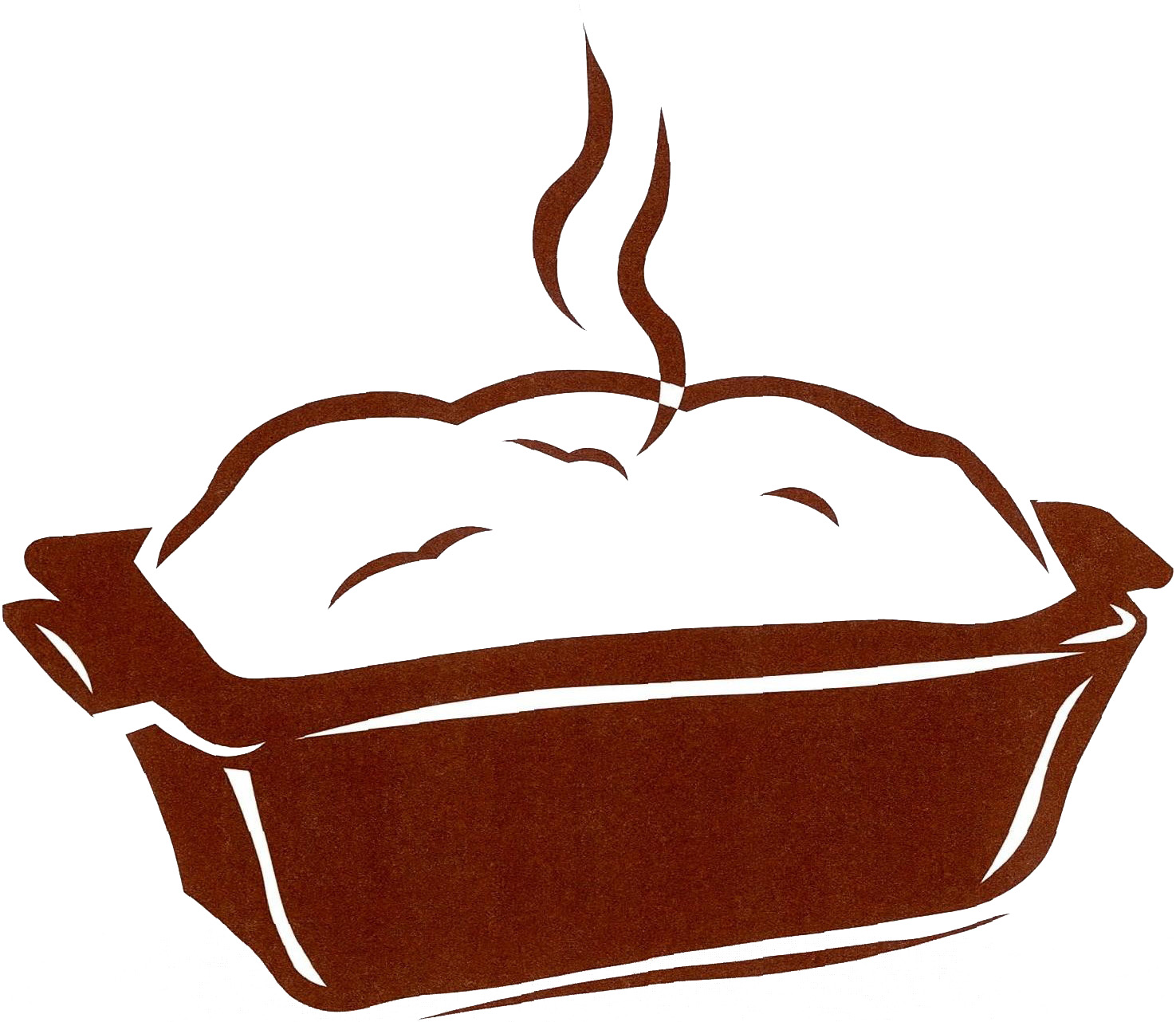
Quick Loaves
Quick loaves rely exclusively on the power of chemical leaveners to make their batters light and fluffy. Before the invention of the baking powder mixture by a German inventor in the late 1800s, loaves were compact and dense, usually raised with yeast, naturally fermented starters, beer, or eggs. Early Americans used saleratus (an early form of bicarbonate of soda converted from sea salt), hartshorn (the ground antler of a male deer, the chief source of ammonia), cream of tartar, and pearlash (ashes from wood, seaweed, pea, or bean stalks) for leavening home quick breads, each with its own pronounced flavor. All of these forms of leavening were at times scarce and often unreliable, producing baked goods of inconsistent quality.
Because of the capricious nature of these leavenings, early cookbooks advised bakers to keep the oven shut during baking, to avoid drafts, to dissolve leavenings in water to prevent black spots, to beat batters laboriously by hand for long periods, and never to let a finished batter stand, as it would lose its slightly raised texture very quickly. Adding to the bakers difficulties was the fact that these loaves were often baked in wood cookstoves, known for their quick, intense, and uneven heat. Although some of these directions might still be included in a modern recipe, most are leftovers from another era, made unnecessary by todays reliable leaveners and consistent ingredients.
Modern baking powders are double acting, which means that they begin to rise as soon as the leavening is moistened in the batter and then again during the baking process. Most of the carbon dioxide produced gets released in the oven, making a stable batter that bakes into a high, light bread. With double-acting baking powders, batters can rest overnight in the refrigerator and still bake into an excellent loaf. Aluminum sulfate, a common ingredient in commercial baking powder, can be tasted in quick breads by some people, so I recommend a nonaluminum baking powder sold under the commercial name of Rumford. For more information on leavenings and how to make your own single-acting baking powder, which makes a tender and flavorful baked good, see Notes from the Kitchen, .
The modern quick loaf is a purely American product, with a taste and texture between a yeasted bread and a sweet cake. A large assortment of breads can be made by a simple variation in ingredients. They are delicious with added seasonal fresh or dried fruits or accented with luscious liqueurs, chunks of mellow nuts, creamy cheeses, aromatic herbs, and pungent exotic spices.
Next page
